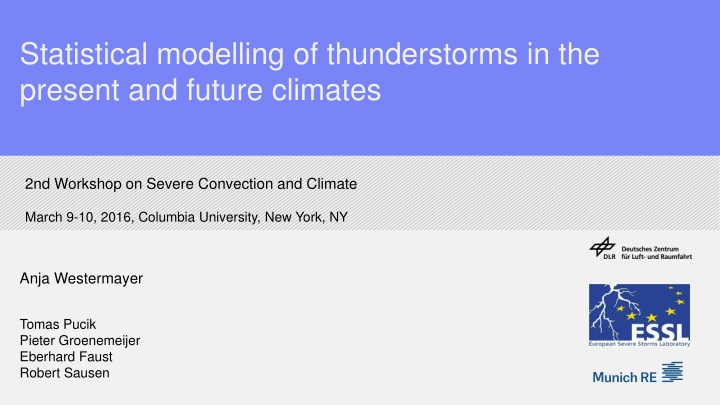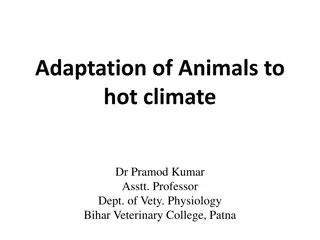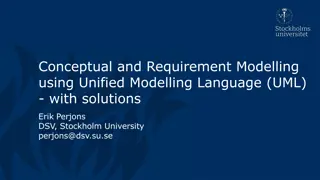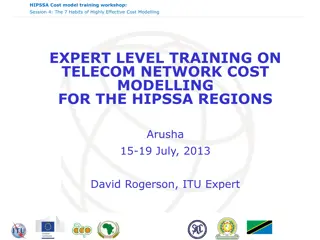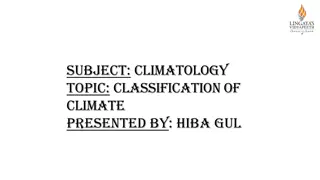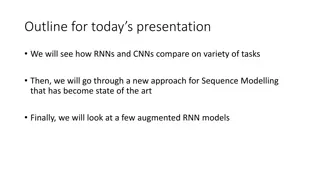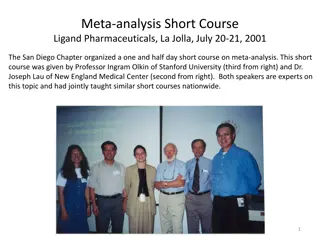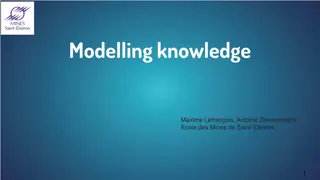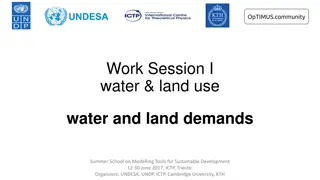Statistical Modelling of Thunderstorms in Present and Future Climates
Workshop on Severe Convection and Climate at Columbia University discussed modelling thunderstorm climatology in Europe using reanalysis data and predicting future climate changes. Lightning observations, additive logistic regression, and probability analysis in different parameter spaces were explored to understand thunderstorm patterns. The study highlighted the annual cycle of thunderstorms, hotspots in northeast Italy, and overestimation in winter. Various parameters like instability, moisture, and shear were analyzed to model thunderstorms using both EUCLID lightning data and ERA-Interim global atmospheric reanalysis data.
Download Presentation

Please find below an Image/Link to download the presentation.
The content on the website is provided AS IS for your information and personal use only. It may not be sold, licensed, or shared on other websites without obtaining consent from the author.If you encounter any issues during the download, it is possible that the publisher has removed the file from their server.
You are allowed to download the files provided on this website for personal or commercial use, subject to the condition that they are used lawfully. All files are the property of their respective owners.
The content on the website is provided AS IS for your information and personal use only. It may not be sold, licensed, or shared on other websites without obtaining consent from the author.
E N D
Presentation Transcript
Statistical modelling of thunderstorms in the present and future climates 2nd Workshop on Severe Convection and Climate March 9-10, 2016, Columbia University, New York, NY Anja Westermayer Tomas Pucik Pieter Groenemeijer Eberhard Faust Robert Sausen
Motivation Goals: How well can we model thunderstorm climatology in Europe using reanalysis data? What changes can we expect in future climates?
Lightning- and Reanalysis Data European Cooperation of Lightning Detection EUCLID* cloud-to-ground (CG) lightning data (comparable to NLDN) Lighting cases between 2008-2013 resolution: ? = 1 , ? = ? = 0.25 Era-Interim global atmospheric reanalysis data** resolution: ? = 6 , ? = ? = 0.75 ,? = 37 ?????? Instability-, moisture- and shear related parameters for the time period 2008-2013 Thunderstorm definition: at least two CG detections within a gridbox * DIENDORFER, G., et al., 2010: EUCLID State of the Art Lightning Detection. 1 21. **DEE, D., et al. , 2011: The ERA-Interim reanalysis: Configuration and performance of the data assimilation system. Q. J. R. Meteorol. Soc. 137(656), 553 597
Probability of lightning in CAPE RH parameter space Dry midlevel air strongly suppresses CI linear logistic regression observations relative frequency of lightning ?? 4
Probability of lightning in CAPE RH parameter space additive logistic regression (2D) observations relative frequency of lightning ?? 5
Lightningobservations (EUCLID) 2008-2013 south north all north south Annual cycle of thunderstorms July is peak season Hotspot in northeast Italy
Additive logistic regression (3D: LI, RH and DLS) ERA-Interim 2008-2013 south north north south Annual cycle fairly well reproduced Overestimation of thunderstorms in winter Hotspot in northeast Italy
Additive logistic regression (3D: LI, RH and DLS) ERA-Interim 1979-2013 north south north south Discontinuity around 2002 for south domain Hotspot in northeast Italy
EuroCORDEX regional climate simulations High-resolution regional climate change ensemble for Europe within the World Climate Research Program Coordinated Regional Downscaling Experiment (EURO-CORDEX) initiative*. resolution: ? = 6 , ? = ? = 0.44 (approx. 50 km) periods: 1971 2000, 2071 2100 Greenhouse gas emission scenarios (RCPs): RCP4.5: radiative forcing after the 21st century at 4.5 W/m RCP8.5: radiative forcing > 8.5 W/m at the end of 21st century Preliminary results from the first model SMHI MPI-ESM-LR (GCM) Acknowledgment: Rowan Fealy (NUIM), Claas Teichman (HZG), Erik van Meijgaard (KNMI), Grigory Nikulin (SMHI), Andreas Prein (WEGC) * Jacob, D., et al. "EURO-CORDEX: new high-resolution climate change projections for European impact research." Regional Environmental Change 14.2 (2014): 563-578.
Additive logistic regression (3D: LI, RH and DLS) EuroCORDEX smhi MPI-ESM-LR 2071 2100 Distribution of historical thunderstorms Change in thunderstorm probability for rcp8.5 modelled average of thundery 6h periods per year Underestimation of instability on North Italy Differences between 2071-2100 to 1971-2000 1971 - 2000
EuroCORDEX SMHI MPI-ESM-LR differences between 2071-2100 to 1971-2000 Change in 1st percentile of LI rcp 4.5 rcp 8.5 (K)
EuroCORDEX SMHI MPI-ESM-LR differences between 2071-2100 to 1971-2000 Change in 1st percentile of RH rcp 4.5 rcp 8.5 (%)
EuroCORDEX SMHI MPI-ESM-LR differences between 2071-2100 to 1971-2000 Change in 1st percentile of DLS rcp 4.5 rcp 8.5 (m/s)
Conclusions How well can we model thunderstorm climatology in Europe using reanalysis data? with some limitations in winter Fairly well with an additive logistic regression (3D: LI, RH and DLS) What changes can we expect in future climates? small increases of the number of thunderstorms in most of Central Europe small decrease in the number of thunderstorms in the South of Europe
Conclusions Thank you for your attention! Changes in DLS small throughout the domain for rcp8.5 2071 2100 change in percent Decrease in relative humidity dominating
EuroCORDEX ensemble (14 members) differences between 2071-2100 to 1971-2000 Change in 1st percentile of LI rcp 4.5 rcp 8.5 (m/s)
EuroCORDEX ensemble (14 members) differences between 2071-2100 to 1971-2000 Change in 1st percentile of RH rcp 4.5 rcp 8.5 (%)
EuroCORDEX ensemble (14 members) differences between 2071-2100 to 1971-2000 Change in 1st percentile of DLS rcp 4.5 rcp 8.5 (m/s)
Additive logistic regression (3D: LI, RH and DLS) EuroCORDEX smhi MPI-ESM-LR 2071 2100 Distribution of historical thunderstorms Change in thunderstorm probability for rcp4.5 modelled average of thundery modelled areal average of thundery 6h periods per year 6h periods per year Underestimation of instability on North Italy Differences between 2071-2100 to 1971-2000 1971 - 2000
Generalized linear models (GLM) Generalized additive models (GAM) ? = ?(?1,?2, )+ ? = ?0+ ?1 ?1 + ?2 ?2 + constant error explanatory or predictor variables smoothing function response variable coefficient Y and X don t have to be linearly related Term linear refers to the combination of parameters, not the shape of the distribution No theory or mechanistic model assumption needed Y and X are not linked by coefficient but by a smoothing function ? Logit link: ? ? = log( 1 ?) Smoothing function is estimated from available data models log of odds of one outcome (e.g. presence) ? Logit link: ? ? = log( 1 ?) Linear Logistic Regression Additive logistic regression
Atmospheric parameter: CAPE, CIN, relative humidity and deep-layer bulk shear deep-layer bulk shear DLS relative humitity
